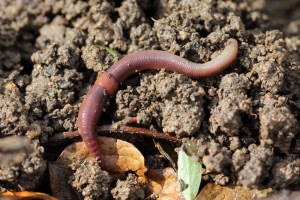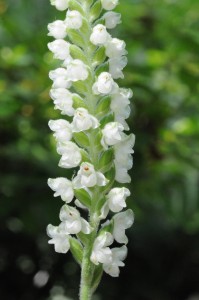by Kristen Minogue

Lumbricus rubellus, a European earthworm that is now one of the most common in the eastern U.S. More than 10,000 years ago, Pleistocene glaciers wiped out native earthworms. Today virtually all earthworms in the U.S. north of Pennsylvania are invasive. (Holger Casselmann)
But for wild orchids, they’re more of a menace. Earthworms could prevent roughly half a forest’s orchid seeds from even germinating, ecologists from Smithsonian Environmental Research Center and Johns Hopkins University discovered in a study published online this March in Annals of Botany Plants.
The small size of orchid seeds (they are barely the size of dust grains) makes them particularly vulnerable. As earthworms chew up forest litter, they ingest orchid seeds as well. When that happens, two things can keep the seeds from germinating: One, the process of passing through an earthworm’s gut can render them unviable. Or two, if the seeds survive ingestion, they can end up buried so deep that they can’t access the fungi they need to germinate and grow. As a general rule, deeper soils are much less likely to have those fungi.
The idea that earthworms can be good for gardens but terrible for forests isn’t surprising to the study’s authors. SERC ecologists Melissa McCormick and Dennis Whigham have spent several years tracking the trouble with earthworms, along with Katalin Szlavecz of Johns Hopkins University. Many forest plants, especially in older forests, are used to getting their nutrients from the soil. But earthworms’ ability to make nutrients easier to access can favor invasive plants that can later take over the understory. Added to that, almost all earthworms in the eastern U.S. aren’t native to the area. The issue with orchids is just their latest discovery.
For this study, McCormick, Whigham, Szlavecz and SERC intern Kenneth Parker tested seeds of the orchid Goodyera pubescens with three different earthworm species. First, they tested what percentage of seeds would be not be viable after going through an earthworm’s system. After feeding orchid seeds to earthworms in lab, they examined the seeds the earthworms excreted. Almost 80 percent of them were non-viable. Next, they tested what percentage of the seeds the earthworms actually ingested in soils from mature and younger forests. After only six weeks, the worms had already ingested 19 percent of the seeds—and the team estimates earthworms are active more than five times that long in a given year.Finally, they investigated how deep earthworms buried the seeds. McCormick had already calculated that in order for Goodyera orchids to germinate and grow, they need to be in the top 5 centimeters of soil. Anything deeper and there wouldn’t be enough of the fungi they require to grow properly. Of the seeds that were ingested, almost a third were buried deeper than the 5-centimeter cutoff point.
Expanding the numbers over an entire year, the team estimated 49 percent of Goodyera orchid seeds would be lost in older forests (120-150 years old). In younger forests (50-70 years old), where non-native earthworms generally do better, the figure jumped to 68 percent.
But McCormick suspects even these numbers may be too low. The worms didn’t chew up nearly as much material in lab as they do in nature, and they weren’t able to count seeds that were fragmented or completely digested. What the authors uncovered is probably the lower limit—the true number of orchid seeds lost to earthworms is almost certainly higher.


